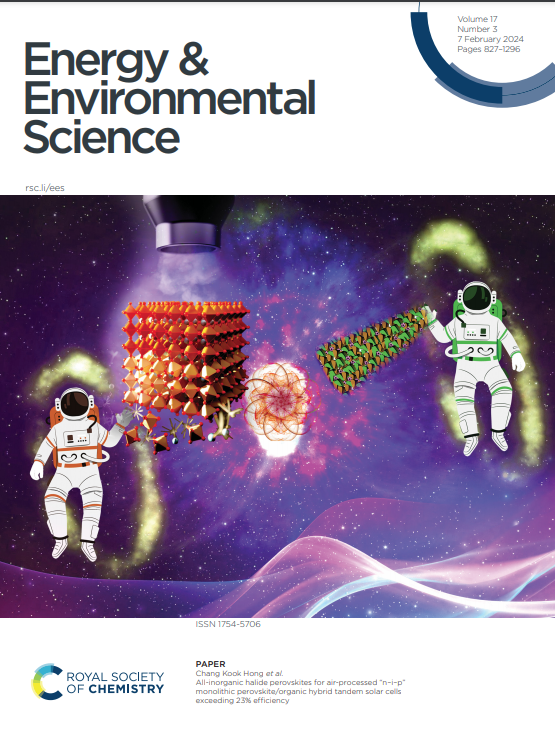全钙钛矿串联太阳能电池的界面平行偶极子调节
IF 30.8
1区 材料科学
Q1 CHEMISTRY, MULTIDISCIPLINARY
引用次数: 0
摘要
摘要应该用一段话概括文章的内容,构建全钙钛矿串联太阳能电池(TSCs)提供了超越单结器件效率极限的有效途径。然而,宽带隙(WBG)亚电池中巨大的非辐射复合损失降低了其理论预测的性能。在这里,我们提出了一种平行偶极子工程策略,采用定制的苯氧乙基卤化铵(POEAX, X=I, Br, Cl)来同时修复缺陷和调制界面电场。POEA+在钙钛矿/C60界面形成平行偶极矩,有效结合Pb2+缺陷,增强载流子输运。协同作用下,Cl-放大了偶极子桥接的缺陷愈合并优化了能级排列,从而大大改善了薄膜的均匀性并抑制了复合。这些优点导致1.77 eV WBG钙钛矿太阳能电池(PSCs)的功率转换效率(PCE)达到19.54%,开路电压为1.352 V。此外,与低带隙PSCs集成,实现了PCE最高达28.92%(经认证为28.51%)、稳定性优异的全钙钛矿TSCs。本文章由计算机程序翻译,如有差异,请以英文原文为准。
Interface parallel dipole regulation in all-perovskite tandem solar cells
The abstract should be a single paragraph that summarises the content of the article Constructing all-perovskite tandem solar cells (TSCs) provides an effective route to surpass the efficiency limit of single-junction devices. However, huge non-radiative recombination losses in wide-bandgap (WBG) subcells degrade their performance from theoretical predictions. Here, we propose a parallel dipole engineering strategy employing tailored phenoxyethylammonium halides (POEAX, X=I, Br, Cl) to simultaneously heal defects and modulate interfacial electric fileds. POEA+ forms parallel dipole moment at the perovskite/C60 interface, effectively binding with Pb2+ defects and enhancing the carrier transport. Synergistically, Cl- amplifies the dipole-bridged defect healing and optimizes the energy level alignment, leading to highly improved film homogeneity and suppressed recombination. These advantages lead to a power conversion efficiency (PCE) of 19.54% and a remarkable open-circuit voltage of 1.352 V in 1.77 eV WBG perovskite solar cells (PSCs). Furthermore, integrated with low-bandgap PSCs, all-perovskite TSCs with a champion PCE of 28.92% (certified 28.51%) and excellent stability are realized.
求助全文
通过发布文献求助,成功后即可免费获取论文全文。
去求助
来源期刊

Energy & Environmental Science
化学-工程:化工
CiteScore
50.50
自引率
2.20%
发文量
349
审稿时长
2.2 months
期刊介绍:
Energy & Environmental Science, a peer-reviewed scientific journal, publishes original research and review articles covering interdisciplinary topics in the (bio)chemical and (bio)physical sciences, as well as chemical engineering disciplines. Published monthly by the Royal Society of Chemistry (RSC), a not-for-profit publisher, Energy & Environmental Science is recognized as a leading journal. It boasts an impressive impact factor of 8.500 as of 2009, ranking 8th among 140 journals in the category "Chemistry, Multidisciplinary," second among 71 journals in "Energy & Fuels," second among 128 journals in "Engineering, Chemical," and first among 181 scientific journals in "Environmental Sciences."
Energy & Environmental Science publishes various types of articles, including Research Papers (original scientific work), Review Articles, Perspectives, and Minireviews (feature review-type articles of broad interest), Communications (original scientific work of an urgent nature), Opinions (personal, often speculative viewpoints or hypotheses on current topics), and Analysis Articles (in-depth examination of energy-related issues).
 求助内容:
求助内容: 应助结果提醒方式:
应助结果提醒方式:


